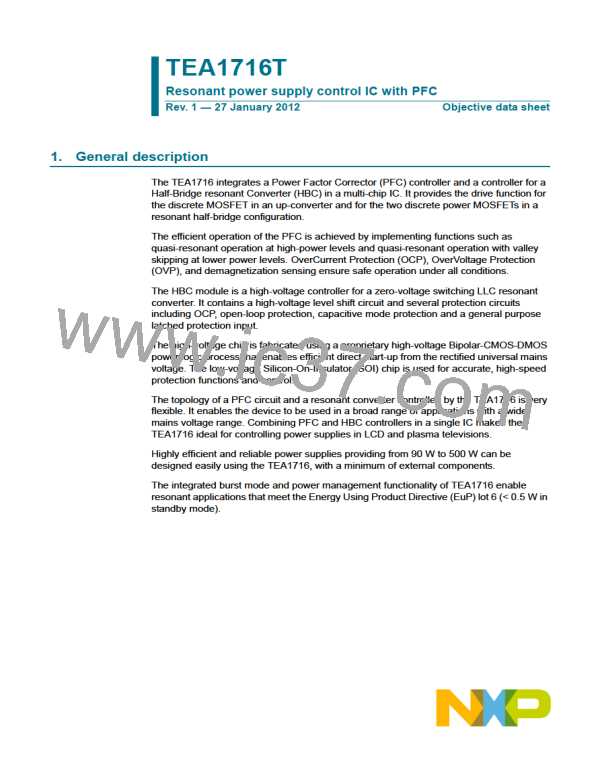TEA1716T
NXP Semiconductors
Resonant power supply control IC with PFC
V
RFMAX
f
max
f
HB
V
fmax,ss(RFMAX)
f
HB
V
fmax,fb(RFMAX)
V
RFMAX
f
min
0
0
V
V
fmax(SSHBC)
clamp(SSHBC)
fmin(SSHBC)
V
V
pu(EN)
V
SSHBC
< I
fmin(SNSFB)
I
I
SNSFB
< I
< I
fmax(SNSFB)
fmin(SNSFB)
SNSFB
014aaa863
Fig 13. Relation between SSHBC/EN voltage and frequency
VRFMAX and VSSHBC/EN are of opposite polarity. At initial start-up, VSSHBC/EN is below
fmax(SSHBC) (3.2 V typical), which corresponds to the maximum frequency. During
V
start-up, Css(HBC) is charged, VSSHBC/EN rises and the frequency decreases. The
contribution of the soft start function is zero when VSSHBC/EN is above Vfmin(SSHBC)
(7.9 V typical).
VSSHBC/EN is clamped at a maximum of Vclamp(SSHBC) (8.4 V typical) (frequency is at a
minimum) and at a minimum ( 3 V). Below Vfmax(SSHBC) (maximum frequency), the
discharge current is reduced to a maximum-frequency soft start current of typically 5 A
The voltage is clamped at a minimum of Vpu(EN) (3 V typical). Both clamp levels are just
outside the operating area of Vfmax(SSHBC) to Vfmin(SSHBC). The margins avoid frequency
disturbance during normal output voltage regulation, but ensure that overcurrent
regulation can respond quickly.
7.8.8.2 Soft start charge and discharge
At initial start-up, the soft start capacitor Css(HBC) is charged to obtain a decreasing
frequency sweep from maximum to operating frequency. In addition to being used to soft
start-up the resonant converter, the soft start functionality is used for regulation purposes
(such as overcurrent regulation). Css(HBC) can therefore be charged or discharged. If
overcurrent regulation occurs, a continuous alternation between charging and discharging
takes place. In this way, VSSHBC/EN can be regulated, overruling the signal from the
feedback input.
The charge/discharge current can have a high value, Iss(hf)(SSHBC) (160 A typical),
resulting in a fast charge/discharge. Or it can have a low value, Iss(lf)(SSHBC) (40 A
typical), resulting in a slow charge/discharge. This two-speed soft start sweep allows for a
combination of a short start-up time for the resonant converter and stable regulation loops
(such as overcurrent regulation).
The high charge/discharge speed is used for the upper frequency range where
VSSHBC/EN is below Vss(hf-lf)(SSHBC) (5.6 V typical). In the upper frequency range, the
currents in the converter do not react strongly to frequency variations.
TEA1716T
All information provided in this document is subject to legal disclaimers.
© NXP B.V. 2012. All rights reserved.
Objective data sheet
Rev. 1 — 27 January 2012
26 of 46

 ETC [ ETC ]
ETC [ ETC ]